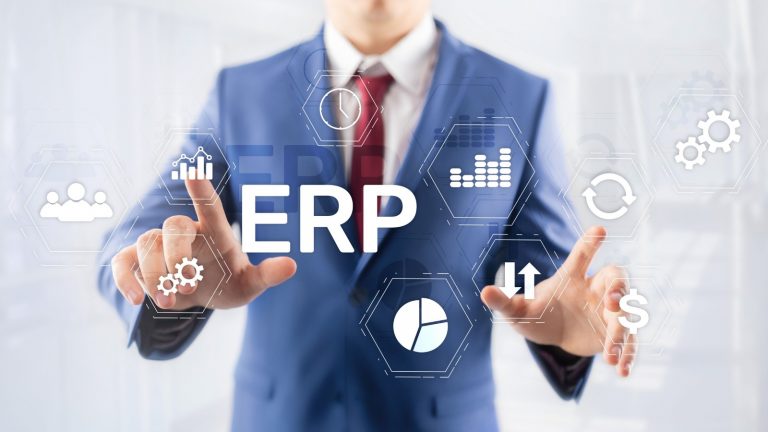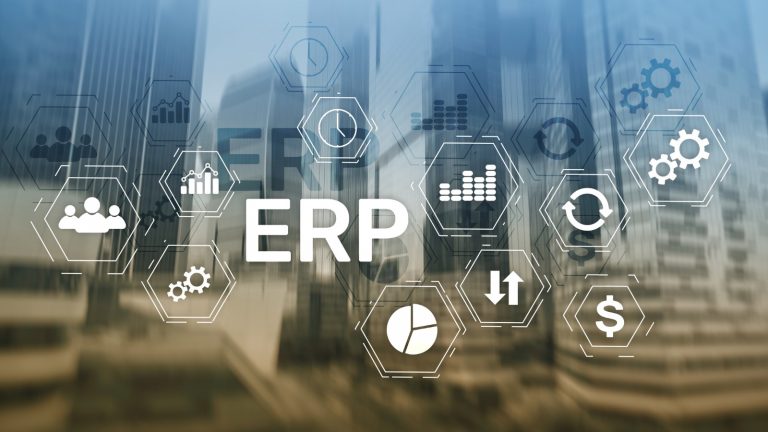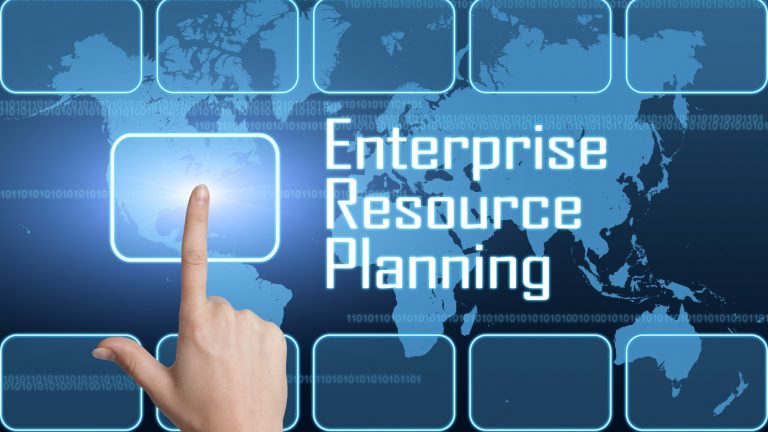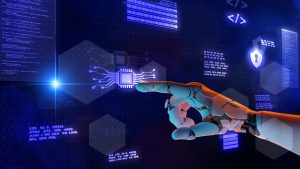In a world full of an unlimited number of businesses or enterprises ranging from small to mega-sized, the management has to face numerous challenges when unifying industry requirements and their business processes. This is where ‘ERP, Enterprise Resource Planning Software’ enters the spotlight as the most trendy solution for all the obstacles in the enterprise resource management realm. This acts as an all-in-one unification for the business world, as it takes care of everything from streamlining operations and optimising decision-making to remaining competitive in today’s evolving market.
In this article, we will look into the enterprise resource management trends for 2024 and how systematic enterprise resource planning aids businesses in accomplishing their targets.
We will reveal
What is ERP-Enterprise Resource Planning Software?

- Enterprise Resource Planning or, in brief, ERP, stands as an all-in-one software solution specifically designed to cater to diverse business processes, functions, and data streams into a sophisticated singular system.
- Serving as the nucleus of organisational management, ERP integrates critical operations spanning finance, human resources, manufacturing, supply chain, customer relationship management (CRM), and more.
- ERP boosts overall productivity by providing a real-time, comprehensive view of organisational processes. This allows for more flexible decision-making. What businesses will receive through enterprise resource planning programmes is a 360-degree view of their operations.
- These systems usually feature modular designs that are designed to meet certain business needs. This allows them to provide a flexible and adaptable framework that can be used to meet a variety of operational demands.
What Does the Future of ERP Look Like?

- According to a Gartner report, by 2024, 70% of mid-sized businesses are predicted to be integrating Artificial Intelligence (AI) and ML (Machine Learning) into their ERP systems.
- ERP dominance is anticipated to be expanded more and more as the global cloud ERP market is estimated to grow at a CAGR of 7.55% by 2026.
- ERP systems are a critical facilitator of these efforts, as seen by the fact that 86% of assessed organisations have started investing in sustainability initiatives, according to Deloitte research.
- ERP is projected to extend its capacity by including AI integration, cloud adoption, and sustainability practices into its dominance to restructure the future of enterprise management.
- ERP system security and data processing capabilities might be improved by integrating blockchain technology with quantum computing, a new trend in the industry.
The Top 6 Enterprise Resource Management Trends for 2024

AI and Machine Learning Integration
In today’s digital world, there is no business processing without the use of AI. Do you agree?
As we can see, in 2024, the integration of AI and machine learning has emerged as a prominent trend in Enterprise Resource Management. Let us show you how.
Businesses are increasingly employing AI and machine learning algorithms to enhance the capabilities of their ERM systems by now. These technologies literally have no limits when it comes to data capacity. Businesses can take advantage of this benefit and use ERP to analyse vast amounts of data from various sources, including customer interactions, supply chain operations, and financial transactions, to generate actionable insights and predictions.
Businesses could improve decision-making, optimise resource allocation, and expedite operations by integrating AI-driven automation and predictive analytics into ERM processes.
Furthermore, proactive risk management and adaptive planning in response to changing market conditions are made possible by the integration of AI and machine learning with ERM.
This trend reflects the growing recognition of the transformative potential of AI and machine learning technologies in optimising resource management and driving organisational efficiency and competitiveness in the rapidly evolving business landscape of 2024.
Explainable AI
Explainable AI, or XAI, has emerged as a prominent trend in enterprise resource management. Since there is an increasing need for transparency and trust in AI-powered decision-making processes, XAi has entered the scenario as the best solution.
If we look at its mechanism, we can witness XAI focuses on developing AI models that not only provide accurate predictions or recommendations but also offer insights into the underlying reasoning behind those outputs in a comprehensible manner. This transparency is what business leaders have required to understand and trust AI-driven decisions over the past period. The technology encourages its adoption across various ERM functions, such as financial forecasting, resource allocation, and risk management.
XAI reduces possible biases and mistakes, improves decision-making processes, and encourages collaboration between people and AI systems by guaranteeing interpretability and responsibility.
Ultimately, the adoption of XAI in ERM empowers organisations to receive the maximum benefits of AI technologies while maintaining control and confidence in their decision-making processes.
Yes, it strikes the right balance in the business framework.
Cloud-based ERP Solutions
Cloud-based Enterprise Resource Planning solutions are one of the most wanted answers in the business realm due to their numerous advantages and increasing adoption rates.
These solutions offer scalability, flexibility, and accessibility, allowing organisations to efficiently manage their resources across different locations and departments. If they can employ cloud technology, businesses can access their ERP systems from anywhere with an internet connection. This capacity facilitates remote work and enhances collaboration among teams. This has received so well in the corporate world as remote collaboration has become the trend itself after the pandemic.
It is unnecessary to specifically mention that these cloud-based ERP solutions provide real-time data insights. Yes, in one way, it backs up agile decision-making and a faster response to market changes.
However, in another way, if you opt for a subscription-based pricing model for cloud ERP, it can eliminate the need for upfront investments in hardware and infrastructure. This means making it more cost-effective for businesses of all sizes.
Mobile ERP Accessibility
Who does not leverage the benefits of mobile apps nowadays?
Yes, this laid the foundation for mobile ERP apps, and they have risen above everything else in the market as a prominent trend in Enterprise Resource Management for 2024. This is because of the increasing reliance on mobile devices and the need for flexibility in accessing business data.
Employees now expect to be able to access essential ERP functions from anywhere at any time because of the widespread use of smartphones and tablets.
The outstanding feature of these mobile ERP solutions is that they allow users to perform various tasks such as accessing real-time data, approving workflows, and monitoring key performance indicators on their mobile devices. This accessibility enhances productivity by enabling employees to make informed decisions on the go and collaborate seamlessly, regardless of their location.
Plus, mobile ERP apps specifically empower field workers and remote teams to stay connected with the central ERP system, facilitating faster response times and better customer service.
Due to this rising trend, responsiveness has expanded in the business world.
IoT Integration
This technology has emerged as a trend, driven by the potential to optimise resource utilisation and enhance operational efficiency.
How is that possible? Let us explain. IoT devices embedded with sensors and connectivity capabilities enable organisations to collect real-time data from various assets, including machinery, equipment, and inventory. When IoT data streams are integrated into ERP systems, businesses can easily gain valuable insights into asset performance, usage patterns, and supply chain dynamics.
From this mechanism, what you receive is visibility. The latter allows for proactive maintenance, inventory optimisation, and demand forecasting, leading to cost savings and improved resource allocation.
Another fact is that IoT integration permits predictive analytics, and this capacity empowers enterprises to anticipate and mitigate potential disruptions, such as equipment failures or supply chain bottlenecks.
Considering operational excellence in the business world as the outcome, do you wonder why this has become a trend?
Enhanced Cybersecurity Measures

As the business world and technologies grow, the cybersecurity threat also keeps growing.
The latter has become a trend in enterprise resource management due to the escalating threat landscape in 2024 and the critical need to safeguard sensitive business data and resources.
As organisations increasingly rely on digital technologies for resource management, they face heightened risks from cyberattacks, data breaches, and other malicious activities. As a result, companies are placing a high priority on putting strong cybersecurity safeguards in place throughout their ERM ecosystems to guard against hacking, data theft, and system weaknesses.
This includes deploying advanced encryption protocols, multi-factor authentication, and intrusion detection systems to fortify their defences against cyber threats.
Also, organisations are investing in employee training programmes to raise awareness about cybersecurity best practices and promote a culture of security within the workforce.
Bridging Gaps in Enterprise and Resource Planning in 2024

It is a good thing that the business world keeps growing through such evolving trends, and as the requirements keep growing day by day, businesses should have the potential to cater to these needs without hesitating. When you follow a trend, you receive the courage to believe that you are capable of competing in the dynamic business world, and your knowledge base also expands unlimitedly. However, it is also important to understand the requirements for a certain trend without following it blindly. Our friendly advice for you is to collaborate with an industry expert if you are planning to make a technological integration.






